

Histories of Terre HauteBurrell TownshipDecatur County, Iowa |
HISTORICAL SKETCH
By David O. Thomas |
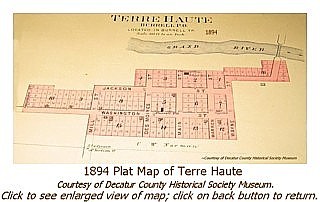 The
early settlers of the Terre Haute, Decatur County, Iowa, vicinity were
the Pottawattamie Indians. There was an Indian trading post about one
and a half miles northwest of the townsite. There are two Indian graves
on the Butcher farms south of Terre Haute. One is that of Chief Potorf,
buried in a hollowed out walnut log, and his rifle buried with him.
There are others on the old Thomas Williams farm, (now Winfield Norman
farm). There was a scaffold in a tree, up the river, where the Indians
left their dead for the vultures to dispose of. The
early settlers of the Terre Haute, Decatur County, Iowa, vicinity were
the Pottawattamie Indians. There was an Indian trading post about one
and a half miles northwest of the townsite. There are two Indian graves
on the Butcher farms south of Terre Haute. One is that of Chief Potorf,
buried in a hollowed out walnut log, and his rifle buried with him.
There are others on the old Thomas Williams farm, (now Winfield Norman
farm). There was a scaffold in a tree, up the river, where the Indians
left their dead for the vultures to dispose of.In the early days, before the town was started there was an Indian brave, son of a chief, killed at the trading post by Albert and Green Forkner, uncles of Riley Forkner of Leon. The Indians assembled to retaliate for their law was a life for a life. However, a compromise was effected and there were no more lives lost. When the Indians left here they went to Oklahoma but returned every spring to make syrup from the hard maple trees along the river bank. Their last trip for syrup making was in the early 1880's. When they left they buried their kettles and two lots of them have been plowed up in later years. In the early 1840's Frank Miller and Alan Scott left their wives in Indiana and picked up a couple of girls and came here to establish their homes. Scott soon faded out of the Terre Haute picture, but Miller remained and raised a fine family of boys. There were John, Perry, Andrew, Maurice and Frank. The wives of the two men came later to look for them but were frozen to death in a blizzard. The law caught up with Miller and made him get married. Young Frank lost a leg in the Civil war and walked on a peg leg. Some one had a good watermelon patch and someone made a raid on it, then used a stick and walked through the patch to imitate the track of a peg leg, throwing suspicion on Frank Miller, but Frank wasn't that kind of man. Mordicia (Dick) Miller* came from Terre Haute, Indiana, in 1850. He was no relation to Frank Miller. The Millers stopped at Ottumwa, Iowa, long enough for a baby to be born. They named her Ottumwa. In 1854 Miller acquired 1000 acres of land at $1.25 per acre, laid out a townsite, called it "Terre Haute", and sold lots. William Toney was the first merchant and freighted his goods from Ottumwa by ox team. Another store was soon opened by Mr. and Mrs. William Carroll which they operated for many years. 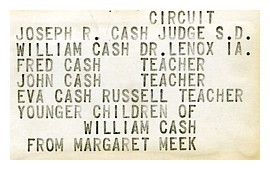 Among
the early settlers were the Slauters, Normans, Williams, Cash's,
Sellers, William Gray--there was something phony here for my uncle told
me that when he knew him in Michigan his name was "Ray." There were the
Toneys, Odells, Shafners, McGahueys, Joe Lucas (he still has a
granddaughter, Mrs. Vurna Norman, living in the neighborhood), The
Ellars family, Orfields, McDowells, G. W. (Wash) Alley, Sutherlands,
Butchers, Cogstills, Cartrights, and others. Among
the early settlers were the Slauters, Normans, Williams, Cash's,
Sellers, William Gray--there was something phony here for my uncle told
me that when he knew him in Michigan his name was "Ray." There were the
Toneys, Odells, Shafners, McGahueys, Joe Lucas (he still has a
granddaughter, Mrs. Vurna Norman, living in the neighborhood), The
Ellars family, Orfields, McDowells, G. W. (Wash) Alley, Sutherlands,
Butchers, Cogstills, Cartrights, and others.The Slauters and Normans came in 1854 in a wagon train, and they were very prominent in the community for many years. The Normans are still well represented, there being nine Norman families living within fifteen minutes drive of Terre Haute. The Slauter family joined the train in eastern Iowa, and the story goes that young C. W. (Wes) Norman, proud, with a red silk handkerchief about his neck, his hat cocked over one eye, rode a spirited horse past the Slauter wagon. Martha Slauter peeked out and said, "There's my fellow." The two families settled about two miles apart, south of Terre Haute and the young people became acquainted and got married. C. W. Norman was the first man to bring hogs to Terre Haute. He walked to St. Joseph, Missouri, purchased some hogs and drove them on foot back to Terre Haute. A woman came here and abandoned her baby. I have heard two stories. One was that she went to the river to drown him, but her efforts were thwarted. The other was that she abandoned him on the doorstep at the William Carroll home. The Carrolls adopted him and gave him a good education, as good as possible in an elementary school. He was quite a debater. They named him William Marion. He and Isaac Norman were the debaters at the school entertainments and they put on a good entertainment. Carlos Norman and Harrison Orfield were the wrestlers and they put on a good show. William Marion was a consistent reader. He read the Bible a lot, not for the spiritual benefit but to have something to argue about. A Sunday school was organized and William Marion was elected treasurer. When the Sunday school was abandoned there were $2 or $3 in the treasury. Later another Sunday school was organized and someone suggested that there was a little money in the treasury. William Marion said, "No, that wasn't this Sunday school, that was another Sunday school." The fact was that he had spent the money for whiskey. A man from Tennessee or Kentucky came here on horseback to buy cattle. He and Steve Cogstill went up the river to what is now known as "Dead Man's Bend," and participated in a poker game. The cattleman lost his life in the game. Steve went home in the night and told his wife he wanted a clean shirt, his shirt had blood on it for he had killed a man. He left the community a short time later and stayed for a number of years before returning to finish his life here. There is a large tract of river bottomland east of Terre Haute known as "The Big Bottom." Whenever there was a dance in Terre Haute someone was sure to say, "The Big Bottom girls will be over tonight." Brice Miller, son of Dick Miller, fought in the Mexican war. When the war was over he purchased a horse and started back to his home in Terre Haute, Indiana. Each day he kept looking for a likely place to spend the night. As he rode into town he saw a man come out of a house and start splitting wood. He rode up and asked if he could stay over night. "Yes, we never turn anyone away." As they were putting up his horse he thought the old man's face looked familiar, and asked his name. He found it was his father. He did not know the family had left Indiana. 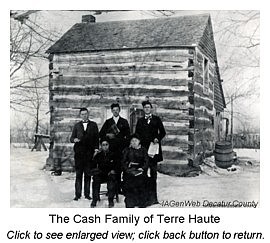 In
the 1880's Terre Haute was fairly well inhabited. There were two stores,
a post office (Burrell), a cooper shop, shoe shop, barbershop,
blacksmith shop (Ham Houdshelt was the blacksmith), a hotel, doctor's
office (Dr. Daniels was the physician). And there was always a chance
for a poker game. The mail was brought to the Burrell post office twice
a week on horseback until the rural route service was established. When
the post office was abandoned, besides those who got their mail on the
route there were fourteen mailboxes in a row on Washington Street. In
the 1880's Terre Haute was fairly well inhabited. There were two stores,
a post office (Burrell), a cooper shop, shoe shop, barbershop,
blacksmith shop (Ham Houdshelt was the blacksmith), a hotel, doctor's
office (Dr. Daniels was the physician). And there was always a chance
for a poker game. The mail was brought to the Burrell post office twice
a week on horseback until the rural route service was established. When
the post office was abandoned, besides those who got their mail on the
route there were fourteen mailboxes in a row on Washington Street.Mr. and Mrs. Jamaica Norman were prominent residents in the east part to town. Their home was a haven for travelers. Many meals were dispensed there and I don't think they ever got a dime out of it. Before a bridge was built across Grand River, travelers would frequently call across and Mrs. Norman would row across and bring them over, frequently furnishing meals before they moved on. A good baseball team was organized in the early days. Tom Butcher, a big, strong lefthander, was the pitcher, and he delivered that ball like it was shot from a cannon. Tom Sutherland stood behind the bat and caught that ball barehanded, a feat ball players don't do now.  There
was a saloon in Terre Haute in the early 1880's, operated by George
Butcher. He also had a pool hall. Ninety-eight-year old John Toney of
Leon got his first drink of beer in that saloon when he was sixteen
years old. I have never heard that there was much trouble with
drunkenness. Oh, there was some drunkenness, but not too bad. There
was a saloon in Terre Haute in the early 1880's, operated by George
Butcher. He also had a pool hall. Ninety-eight-year old John Toney of
Leon got his first drink of beer in that saloon when he was sixteen
years old. I have never heard that there was much trouble with
drunkenness. Oh, there was some drunkenness, but not too bad.There was a level stretch of road south of Terre Haute for about a quarter of a mile where the boys raced horses on Sunday afternoon. Ned Miller was the champion poker player and one could almost always get game at his home. I have heard that he worked half a day once and was an awful good worker. He was always on hand when there was a threshing crew at work and always went in with the crew for dinner. A schoolhouse was built in 1876. Dick Miller furnished the ground for the building. There was an enrollment of 40 to 120 pupils. They put up benches around the room and in the aisles for seats. A number of excellent teachers developed among the pupils of this school, several of whom started teaching after finishing the eighth grade. Among the early teachers was one William Bowman. He had had a tooth pulled about a year before he began teaching and lockjaw set in. In clearing that up he developed a nerve twitch in one side of his face he was never able to control. The school board called him up on the carpet. One of the girls had complained that he was always winking at her. Among the other teachers were: Grover Quite, Kate Grogan, Susie Buritt, Vine Devoss, Winnie Cash, Irven Spencer, Abe Bowman, George O. Johnson, Mrs. Frank Wells, Louisa Butcher, Ed Keeler, Charley Chasey, Emma Ritchie, Fred Cash, Louis Jones, Elizabeth Bolen, Carmaletta Ayres, Henry Ferguson, Winona Alley, Maxine Merrifield, Hildred Hughes, Delma Newcomer, Pauline Smith, Wilma Norman, Joe McMorris, Margaret Dickey, Madge Woodward, Valota Norman, Willard Beck. Among the merchants who operated stores during the years were: William Toney, William Carroll, Railroad Smith, Riley Forkner, Frank Wells, Bert Norman and G. W. (Wash) Alley. Isaac Norman was associated with Alley in the store. Alley was very influential in the community. He married Nancy Norman and to them three children were born: Minnie Winona, Estella and Fred. Minnie married D. O. Thomas (author) in 1895. She lost her life in a fire in 1963. Alley served the community as a Justice of the Peace and constable, and as an all-round do-gooder. He frequently hired help he didn't need. He said, "What would you do? They haven't any money and nothing in the house to eat." |
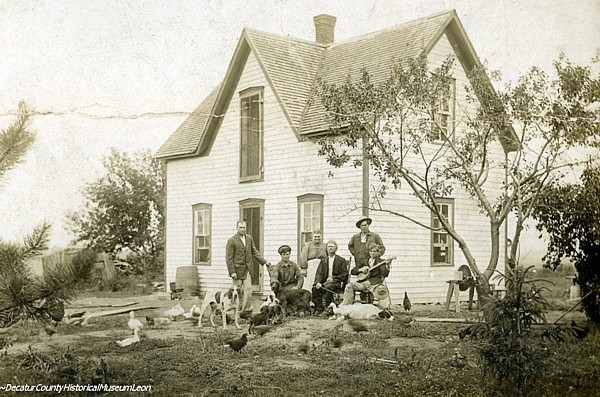 Norman House |
| The C. W. Norman family consisted of Jamaica, Nancy, John, Lincoln,
Carlos, Isaac and Bert. In the Slauter family there were Isaac, Martha,
Manerva, Dennis and William (Doc). Of the Benjamin Norman family there
were C. W. (Wes), Jeff, Sam John, Asberry and James. Four of the Norman boys and Isaac Slauter served in the Civil War. Four of them were sharpshooters. One of the Norman boys was near Isaac Slauter when he was shot and he died in Norman's arms. There were two Normans and a Toney. One of them had $40 on him when he was captured. He hid it in his hair, and it was not found when they searched him. He soon offered the guard $5 to let him out, and furnished money for some of the others to buy their freedom. There is a dispute here over who had the money. The Toneys claim it was a Toney and Ruby Peters declares it was her Uncle Sam Norman. I have been unable to check on this, so they will have to fight it out. Grace River is inclined to overflow its banks about every twenty years. Terre Haute, on the south, is on second bottom above high water. A wooden bridge was built and one day when the river was out of its banks, some of Jamaica Norman's horses went onto the bridge. Just then a large tree floated down the river, struck the bridge and tore it out. I think the horses swam out. It is not uncommon for the river to be half a mile wide during high water. A steel bridge was erected about 1890 just east of where the present bridge now stands. Joe Leeper built the bridge. When the road was rerouted a few years ago the present bridge was built. When rebuilding the road they made a great big S curve right through the middle of town. A railroad was proposed for Terre Haute at one time. The project went far enough so that there was some grading done for the roadbed. A little of the old roadbed may be seen yet, if you know where to look. The schoolhouse burned in 1937. A new building was erected and was used as a community center until a few years ago when the county school board decided to clean house and sold all the rural schoolhouses. The Terre Haute School was sold and turned into a hog house. It was struck by lightning in 1964 and burned. Ralph Silver, of Lamoni, has been spending the summers for many years, camping on the banks of Grand River at Terre Haute. One night he tied up his boat about eleven o'clock and at four o'clock next morning he turned a table upside down, loaded it with his possessions and floated it down to the bridge to get out of the flood. Eventually he decided to build a cottage and put up a very fine structure on the banks of the river just at the west edge of town. He built a stairway down to the water's edge, using old automobile tires for steps, one on top of another. It is unique and very attractive. They are enjoying the place immensely. Following the Civil War a number of soldiers came here to establish their homes. Among them were McDowell, Mart Campbell, Charley Shaffner (he was a Confederate), Frank Miller, G. W. Toms, William Toney, William Logan and others. William Logan was a carpenter, cooper, and a cabinetmaker. The Union soldiers were a little jealous of Shaffner for, being a Confederate, he drew a larger pension than they did. Some of the Union soldiers got as high as $6 a month. A steamboat was floated up the river at one time as far as Terre Haute to see if the stream were navigable. It was decided that there was not sufficient water to make regular trips feasible and the project was abandoned. |
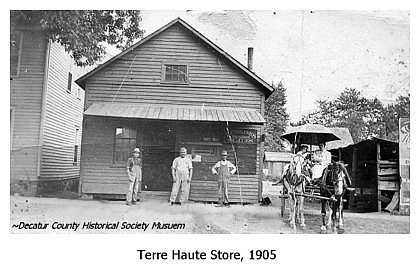 |
History of Terre Haute, Iowa 1849 to 1976By Jay Leroy Toney (deceased)Permission to copy granted by Frank Toney (son of Jay Toney). Transcribed by Earle Koeble |
| On this day, February 12, 1976 Abraham Lincoln's birthday and the
fourth anniversary of the death of my father, Frank Toney, I, Jay Leroy
Toney of Decatur County feel compelled and dedicated to make a plaque to
be displayed at the ghost town of Terre Haute, Iowa, which was founded
and settled by my ancestors, Mordecai Miller [he signed his name:
Mordecai D. Millar] 1810-1880 and "Talton" [Tarlton] Toney 1794-1867. Until proven otherwise, I claim to have the most complete and factual record of both Terre Haute and Tuskeego, Iowa. I feel it is only fitting that I write a history of Terre Haute in this bi-centennial year 1976. I hope to complete one of Tuskeego, Iowa, later. Mordecai Miller married Margaret Toney 1821-1910, daughter of "Talton" Toney, in Terre Haute, Indiana. "Talton" Toney's son, William Ray Toney 1822-1903 married Mordecai Miller's daughter Earyan 1831-1900, by a previous marriage. In either the late forties or early fifties, Mordecai Miller and his wife Margaret (Toney) Miller, arrived with their team of oxen and freighter wagon from Terre Haute, Indiana, to the place on the south bank of Grand River that Mordecai was later to plat and name Terre Haute, Iowa. Mordecai and his wife had stopped in Ottumwa, Iowa, for the birth of a daughter which aptly was named Ottumwa. As soon as they arrived they built a cabin on the 1000 acres of land Mordecai had bought from the government at Chariton, Iowa, for $1.25 per acre. According to "Bill" Toney III, 1883 still alive in 1976, Margaret (Toney) Miller was a big strong woman, could lift logs and drive horses, or knock a man silly, just like a man. The more I study history of our early settlers, the more I decide they were little more than Indians, always seeking a stream for water and wood to heat their cabins. Even in this bi-centennial year 1976, we see many of our so-called civilized people reverting to these same ways. I personally have great respect and admiration for many of the things the American Indian stands for. The farm I now own, 2 miles southwest of Terre Haute, has an Indian campsite of old "Chief Potoff" clan where my father found a perfect tomahawk, which is still in my possession. In either the late 1853 or early 1854. Mordecai's daughter, Earyan, and her husband William Ray (Bill) Toney I decided to come to the place where Mordecai and Margaret had settled. They brought with them in freighter wagon pulled by oxen two little babies, James and William (Bill) II. Also coming with them were William Ray's father, "Talton" and his English wife, a licensed doctor. The country was still virgin, no roads to mark the way, they didn't know for sure where Mordecai and Margaret's homestead was. They had journeyed far and all were tired. They were on the north side of Grand River and they found a likely spot to camp for the night and decided to stop and would resume their journey in the morning. According to Winfield Norman, (1895 -alive in 1976), and great-grandson of Benjamin Norman (1805-1867), when "Talton" and Bill Toney I woke up with their families in the early morning and were preparing to move on, they heard a rooster crow. They decided there had to be somebody on the other side of the river. They forded the river and who did they find, but Mordecai and his wife Margaret and their family. If it hadn't been for the rooster, they would have passed by on the wrong side of the river. A short time later, either 1854-55, Benjamin Norman came to this same location to settle. It is only fitting that the ghost town of Terre Haute is now assimilated in the farm owned by Ronald Norman, great-great grandson of Benjamin Norman. From 1855-1860, the pioneer settlers poured into Decatur County to take up landholdings. Around the settlement of' Mordecai Miller, which was later to be platted as Terre Haute, Iowa, came the Shaffners, Slaughters, Joe Lucas, who could talk Indian talk, Isaac Toney, another son of "Talton" Toney, who in the 1893 Atlas of Decatur County is listed as "Proprietor of Toney's Stock Farm" which contained approximately 1,000 acres, also the Butchers, who had the distinction of having a baseball pitcher, Roy Butcher, who was considered for major league tryouts. Even as late as the depression, Drought, grasshoppers, cinch bugs, and severe winters of the 30s, I Personally remember shagging flies for the makeshift ball team in the field on the south side of Terre Haute. The Throfmartins ran the gristmill in the west part of Terre Haute. The Shaffners ran the sawmill and measured off lots for their own town, 1/2 mile south of the platted town of Terre Haute. Also worthy of mention is the Bird Family. You can still see the foundation rocks of their once nice home. Also you can still see the remains of the old cave where Margaret (Toney) Miller ran the hotel after her husband, Mordecai, died in 1880. When you talk of the early settlers of Terre Haute you must mention the Odells, McGauheys, Cases, Downwards and the Sutherlins. Of course there were many others too numerous to mention. With this influx of settlers there was need for a store, so on the bank of Grand River, where the Indians had a little trading post, William Ray Toney started the first store in Terre Haute. He made trips to Ottumwa, Iowa, for supplies in a freighter wagon pulled by horses. "Talton" Toney's English doctor wife left him, and married a Robison. Talton got drunk and fell in the river and would have drowned, but there happened to be some people at the little store and they pulled him out. At about this same time in history, 1855-1860, there were about 200 Indians with their squaws and ponies camped about a mile up the river from the site of Terre Haute. They were camped just south of where Elk. Creek enters Grand River. Bill Toney III now living in Davis City, related to me the story of his father, Bill II, sitting on the steps of the store owned by Bill I, with old Joe Lucas (grandfather of Vurna (Butcher) Norman, when a nice looking Indian maiden came to the store to trade. Joe Lucas talked to this girl in Indian talk and she threw her arms around Bill Toney II, who was just a young boy. It embarrassed him so much he went running up the road to his uncle's house, Mordecai Miller. In 1865, when the Civil War broke out and the government called for volunteers, William Ray Toney went to war. He was captured by Rebels and served 6 months in the infamous Andersonville Prison. While in the service he was crowded off a bridge, injuring a leg, and always thereafter walked with a limp and an ornate cane he brought back from the Civil War. When he came home from the war, he and his wife, Earyan, moved into a cave on the south bank of Potoff Creek where my grandfather, John Wilson Toney (1866-1966) was conceived. In 1866, William Ray bought 120 acres in Sec. 30, Burrell Township, from his sister, Tannie (Toney) Miller. This Miller was no relation to Mordecai Miller. An interesting episode concerning the Andersonville prison, worthy of relating is this: William Ray's close friends in Andersonville Prison were Roe Asburn and another unnamed man. William Ray had been able to conceal a 20 dollar gold piece on his person. He bribed a rebel guard to let Roe Asburn, and unnamed man and himself to slip out of prison through the woods for the 20 dollar gold piece. Roe Ashburn and the other man were supposed to pay him back. After enduring many hardships, they made their way back home. The day after they made it home, the war ceased, and the prisoners were sent home by train. Poe Asburn remained William Ray's lifelong friend, but the unnamed man left and was never heard from again and William Ray never forgave him. Mordecai Miller gave the land for the Terre Haute Cemetery. The oldest stone there today is dated 1865. "Talton" died in 1867 and is buried there in an unmarked grave. I think I know where it is and I intend to mark it. Mordecai Miller died in 1880 and has the most prominent stone in the cemetery. Benjamin Norman died in 1867 but is buried in the Creveling Cemetery east of Lamoni. In 1880, the death toll sounded for the town of Terre Haute. In 1880, Terre Haute was fairly well inhabited, there were two stores, the Burrell Post Office, a copper shop, shoe shop, barber shop, Ham Heudshell's blacksmith shop, a hotel, Dr. Daniel's office, and there was a saloon run by George Butcher. John Wilson Toney got his first drink of beer there when he was 16 years old. I took John Toney to the Terre Haute Cemetery on his ninety-ninth birthday in 1965 and he could tell me something about every one's stone except maybe 10 or 12. He even recited a poem to me of which all I can remember is "Old John Rupe, used to set on the stoop and watch the creek run by." This creek runs into Grand River just east of the cemetery. Grandpa John also told me of sitting on the bank of this same creek with Joseph Smith of the '"Reorganized Church of Latter Day Saints" when he was only a lad of 16, discussing the possibilities of the Des Moines Southern Railroad coming through Terre Haute, on to Lamoni, down through Bethany. This railroad had already thrown up a grade at Grand River, at the East side of Terre Haute. The railroad came to Decatur City where $20,000 had been contributed. Here it stopped waiting for contributions from Terre Haute and Lamoni to continue on. The founder of Terre Haute, Mordecai Miller, had died in 1880. No one else could come up with the money in Terre Haute. Lamoni already had the Chicago, Burlington and Quincy Railroad. Leon offered $30,000 and the right-of-way to the south line of Eden Township. The Des Moines-Southern turned its tracks at a right angle and came to Leon, where they already had a railroad. In 1884 it ended. at Cainsville, Mo., and in 1885 was bankrupt. It also nailed the lid on the coffin for the village of Terre Haute. As the towns of Leon and Lamoni grew and prospered, the businesses in Terre Haute began to disappear. In 1886, Dr. Daniels left, a flood wiped out the grist mill, where Bill Toney used to trap 1100 flat heads by closing the mill wheel gate. In 1976, Ralph Silvers and his wife have the burr from this mill mounted in front of their cabin on Grand River at the west edge of Terre Haute. The Shaffners began to die off, as they have more stones in the Terre Haute Cemetery than any other. If a house would burn or be blown down it was never replaced. I had the pleasure of visiting some time last week with Winfield and Vurna (Butcher) Norman. We both came to the conclusion that the hey-day of Terre Haute was definitely over when Bill Toney III moved out of the old hotel once occupied by Mordecai Miller and his wife Margaret (Toney) Miller. This was at the end of world war I. At this same time Ned Miller, son of. Mordecai Miller, a long time. card player and gambler, left. Terre Haute was no more. My mother, Bertha (Duries) Toney, was a staid Holland Dutchman and she always said that all bad Toneys had good wives. So I must repeat a story taken from the Ringgold County Bulletin for the 38th Annual Historical Society. In 1872, the stagecoach line ran from Hopeville to Murray, down to DeKalb, on to Decatur, down through Terre Haute on to Bethany, Mo., then on to St. Joseph, Mo. In 1972, Hopeville was a robust, hell-for-leather frontier town where anything could happen and usually did. Legend says it was the northern terminus of a horse stealing ring that "spirited" horses down the Grand River valley to the mysterious horse thief cave near the present site of the town of Grand River or on to Terre Haute in southern Decatur County where "experts" altered the markings on the horses and then tied them on behind the stage coach and took them on to the St. Joseph, Mo., Army horse markets. If this story is true my ancestors were probably the "experts" as they' were about the only ones in Terre Haute. If they weren't the "experts" they had to know something about the affair. If Terre Haute did take part in these kinds of "shenanigans" they had the tables turned on them as I relate this story told to me by Bill Toney III as witnessed by his father, Bill Toney II. There is a level 1/2 mile stretch of road lying directly south of Terre Haute. The favorite Sunday pastime in the 1870-1880s was to have the horse and pony races on this stretch of road. On this particular Sunday there was in attendance, a small, well built man with intense black eyes. He didn't visit with anyone but watched all the races very intently. Both Dr. Slaughter and Joe Lucas lived at the south end of this stretch of road where the races were held. That night Doc Slauter's fine black saddle mare and Joe Lucas' fine matched team of mules were stolen. The next day, a posse of men trailed them up stream to near Grand River town. They must have been getting close to the culprit as he turned the mules loose, but the posse lost track of the black mare. About one year later, she wandered back into Doc Slaughter's farm and he never knew where she came from. Whether my ancestors were good or bad, we all have to live our individual lives, and I am proud of my heritage. I admire the hardships they had to endure to settle and exist in a "wild land". I also respect the Indian for what he was and I am sure each of us today would feel terribly maligned if we were treated today the way our ancestors treated the Indians. The more I study history, the more I find that all people whether considered good or bad, have some good points and other qualities not so desirable. It is up to each and everyone of us to take stock of himself and do what he thinks is right in his own heart to mate this a better place to live and leave a good heritage for our offspring to celebrate at the Tri-Centennial in 2076. Jay Leroy Toney Lamoni, Iowa |
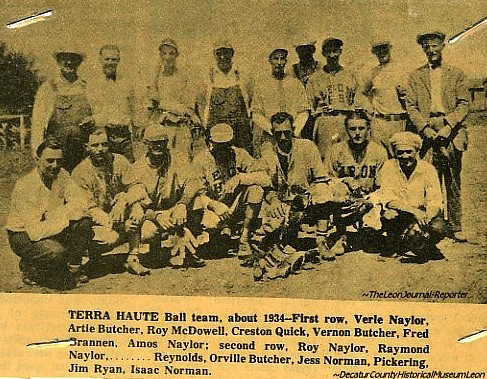 First row, Verle Naylor, Artie Butcher, Roy McDowell, Creston Quick, Vernon Butcher, Fred Brannen, Amos Naylor; second row, Roy Naylor, Raymond Naylor, ..... Reynolds, Orville Butcher, Jess Norman, Pickering, Jim Ryan, Isaac Norman |
| History Index *** Decatur County IAGenWeb |